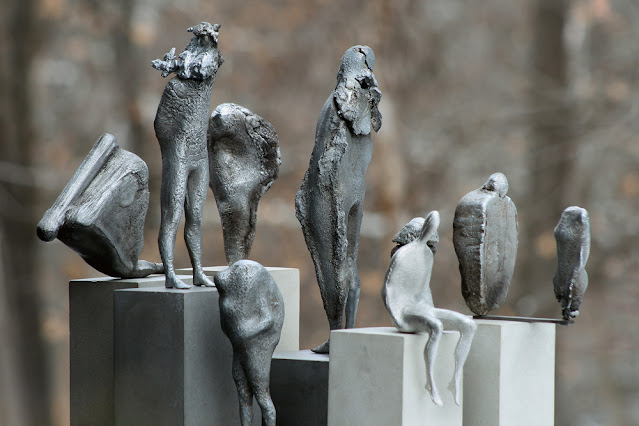SUPERNUMARY: THE SCULPTURES OF EMIL ALZAMORA | Gates of the West
The artist’s attempt to define the ineffable qualities that quantify humanness often result in the construction of effigies closely resembling human appearance. How that artist in question achieves his specific effigy dictates the parameters of his intent. In the case of Emil Alzamora we are presented with two recent series: nearly life size ones with a metallic exterior broken up by striated fissures, like those appearing after an earthquake, titled ‘The Initiates’; and miniature ones that have a molten or melted appearance, under the rubric of ‘Supernumerary.’ Both series play off our reasonable expectation that human forms would naturally take an expressiveness of cerebral repose or narrative energy, yet their fabrication hints at forces far greater than organic life itself—the raging furnace inside planets and stars…the dynamo of creation at work.
THE INITIATES reference an accrual of presences that are unusual in traditional representational sculpture. They attain a rigor of specific intention previously absent in Alzamora’s work. These figures are dramatically suggestive of adolescence, with wistful or brooding poses—the emotional states of those who have not yet matured into roles of social responsibility. The boys (they do all seem overly male) are all sculpted in poses of rest or contemplation, some with legs outstretched and others with back hunched and hands gripped together, heads down—tense, as if in deep thought over some seemingly important matter. It is this changeability that characterizes the passions and impulses of youth. They do not seem to cohere as a group, or any organic social construction, but their poses place them emotionally within a scale of comfort versus discomfort, the intensity of which they share. We see them sitting as a child does, unconsciously and lackadaisically taking up space. Knowing they are meant to be children we do not question how their poses imply a condition of doubt, because in gypsum or in flesh, they remain vessels of vulnerability. We long to hear their thoughts. Their cracked mantle of an exterior makes us think that from within each will emerge a real person—one we could listen to, even take home with us.




Comments